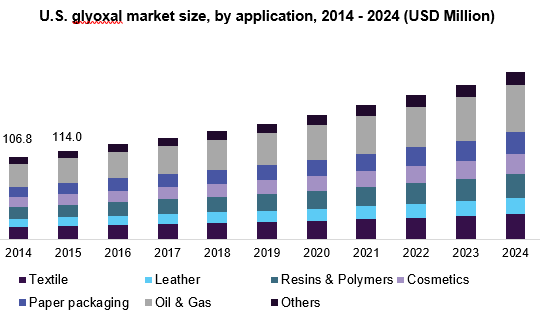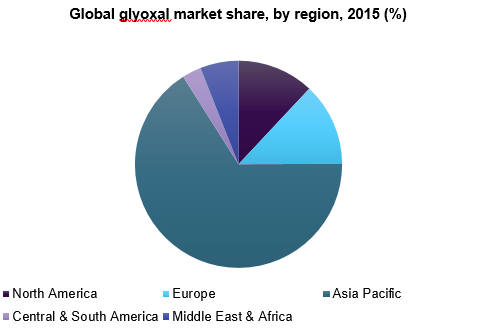- Home
- »
- Organic Chemicals
- »
-
Glyoxal Market Size & Share, Industry Analysis Report, 2024GVR Report cover
![Global Glyoxal Market Size, Share & Trend Report]()
Global Glyoxal Market Size, Share & Trend Analysis Report By Application (Textile, Leather, Resin & Polymers, Cosmetics, Paper Packaging, Oil & Gas), By Region, And Segment Forecasts, 2016 - 2024
- Report ID: 978-1-68038-984-5
- Number of Report Pages: 127
- Format: PDF, Horizon Databook
- Historical Data: 2013-2015
- Forecast Period: 2016 - 2024
- Industry: Bulk Chemicals
Report Overview
The global glyoxal market size exceeded USD 1.30 billion in 2015. Growing end-use industries such as oil & gas, textile, and paper packaging, particularly in emerging economies of the Middle East & Africa and Asia Pacific, is expected to remain a key driving factor for the global glyoxal market over the forecast period.

The chemical is extensively used in food packaging & paper manufacturing applications owing to its low moisture retention characteristic. The shift in the trend toward consuming packaged food owing to fast-paced lifestyles is expected to positively impact demand in the future. In the textile industry, its application includes usage as a cross-linking agent linked with cellulose in order to avoid cellulosic swelling. This leads to enhanced production resulting in soft & wrinkle-free textiles.
Growth dynamics of the industry are expected to be heavily influenced by the trends in the oil & gas industry. Huge investments made by the oil & gas companies in E&P activities, particularly in the countries of the Middle East & Africa such as Nigeria and South Africa are touted to drive demand. The key function of glyoxal is oil recovery and gas sweetening, both of which play an essential role in making both the oil and gas modifiable and usable as per the requirements of end-use.
According to OECD guidelines 301C-E & 303A, glyoxal is considered to be an environment-friendly due to its biodegradable nature, exhibiting over 90% dissolved organic carbon content decrease. It is used as a resistance agent in printing with reactive dyes and as a leveling agent in dyeing polyamide with acid dyes. Such an extensive application field has created growth avenues for market participants in terms of innovation.
At the global level, Asia Pacific is considered to offer immense growth opportunities to the industry. Factors such as rapid industrialization and urbanization are expected to drive demand in the region. The industrialization has resulted in a growing number of manufacturing activities in the region while urbanization has created the need for enhanced public services such as sanitation. The chemical is used in large amounts for various industrial uses such as fillers, intermediates, odor agents, processing aids, and solids separation agents. In terms of consumer use, it is heavily used in water treatment products.
Glyoxal is used in various industries including textile, paper, agrochemicals, oil & gas, leather, cosmetics, agrochemicals, and resin manufacturing. Rising demand for glyoxylic acid production is likely to propel market growth. Glyoxylic acid, a key derivative, is extensively used in various industries such as agrochemicals and pharmaceuticals.
Application Insights
Oil & gas is the major application sector and accounted for 30.4% of the overall volume in 2015. Glyoxal is widely used as a cross-linker for oil recovery, and sulfur scavenger in gas sweetening processes. The recent crash in crude oil prices owing to shale gas discoveries in North America has led to higher oil refining activities in the region. Advanced economies such as the U.S. and Canada are likely to dominate the market for glyoxal applications in this field. Additionally, rising energy needs in emerging economies have led to a high demand for processed oil products in various end-use industries across China, India, Thailand, Vietnam, South Korea, and other Southeast Asian countries
Resins & polymers, which accounted for 16.7% of the overall volume in 2015, and is expected to command a greater share by 2024. The chemical finds application as a cross-linking agent in various polymerization processes. The chemical is gaining importance in cross-linking and masking nucleophiles such as sulfites, amides, amino groups, and hydroxy groups.
Glyoxal is widely utilized as a crosslinking agent or building block for textiles in order to facilitate softer and less wrinkled clothes. The product is increasingly being utilized across emerging textile industries in Asia Pacific on account of its biodegradable and sustainable nature. Glyoxal displays significant potential as a substitute for aldehydes and is likely to gain a higher market share owing to advantageous product characteristics over the coming years.
The global paper packaging market has received an impetus in recent years owing to the increasing problems of land-fill and non-biodegradability of common plastic packaging materials. Slow degradation rates, high prices, and increasing consumption rates of individualized consumer goods are driving the substitution of plastic packaging with eco-friendlier alternatives such as paper.
Regional Insights
Asia Pacific glyoxal market led the global industry and accounted for over 65% of the overall volume share in 2015. Rising demand from key end-use industries such as paper, textile, and oil & gas is anticipated to be a major driving factor for the region’s growth. The region is anticipated to maintain its dominance in 2024 as a result of huge demand in the cosmetic industry purposing cosmetic products that include moisturizers, sunscreen creams, and lotions.
North America is projected to grow at an estimated CAGR of 7.5% from 2016 to 2024. Increasing activity around oil & gas exploration along with strong demand from the packaged food industry is touted to drive demand in the region. Glyoxal finds wide application scope in end-use industries such as agrochemicals and pharmaceuticals and will subsequently benefit North America industry dynamics.

In Europe, increasing demand from end-use industries such as paper packaging, wood adhesives, and leather along with the recovery of economic growth is anticipated to drive market growth in the region over the forecast period. Increasing glyoxal usage in the production of glycolic acid which serves as an intermediate for agrochemicals, antibiotics, vanillin, and allantoin is another key driving factor for regional market growth.
In the Middle East & Africa, exponential growth in the construction industry is anticipated to witness a growing demand for Glyoxal in this region. In addition, Central & South America is projected to a sluggish growth over the coming years due to rising domestic prices and lower consumer spending.
Global Glyoxal Market Share Insights
The global glyoxal market is led by top multinational corporations such as BASF, Silver Fern Chemical, Eastman Chemical, Dow Chemical Co., Huntsman Corp., Formosa Plastics Group, INEOS, ME Global B.V., Shell Chemicals, Reliance Industries, SINOPEC, Clariant, Alberta & Orient Glycol, and Nan Ya Plastics Corp.
There exists a high-level integration from corporations such as BASF and ME Global B.V., as they are involved in raw material production along with a strong distribution network, making them completely integrated across the value chain.
Global Glyoxal Market Report Scope
Report Attribute
Details
Market size value in 2019
USD 1.77 billion
Revenue forecast in 2024
USD2.59 billion
Growth Rate
CAGR of 7.7% from 2016 to 2024
Base year for estimation
2015
Historical data
2014
Forecast period
2016 - 2024
Quantitative units
Revenue in USD billion and CAGR from 2016 to 2024
Report coverage
Revenue forecast, company ranking, competitive landscape, growth factors, and trends
Segments covered
Application, region
Regional scope
North America; Europe; Asia Pacific; Central & South America; Middle East & Africa
Country scope
U.S., Canada, Germany, UK, France, China, India, Japan, Brazil, Saudi Arabia, and UAE
Key companies profiled
ASF, Silver Fern Chemical, Eastman Chemical, Dow Chemical Co., Huntsman Corp., Formosa Plastics Group, INEOS, ME Global B.V., Shell Chemicals, Reliance Industries, SINOPEC, Clariant, Alberta & Orient Glycol and Nan Ya Plastics Corp.
Customization scope
Free report customization (equivalent up to 8 analysts working days) with purchase. Addition or alteration to country, regional & segment scope.
Pricing and purchase options
Avail customized purchase options to meet your exact research needs. Explore purchase options
Frequently Asked Questions About This Report
b. The global glyoxal market size was estimated at USD 1.77 billion in 2019 and is expected to reach USD 1.90 billion in 2020.
b. The global glyoxal market is expected to grow at a compound annual growth rate of 7.7% from 2016 to 2024 to reach USD 2.59 billion by 2024.
b. Asia Pacific dominated the glyoxal market with a share of 66.5% in 2019. This is attributable to rising demand from key end-use industries such as paper, textile and oil & gas.
b. Some key players operating in the glyoxal market include ASF, Silver Fern Chemical, Eastman Chemical, Dow Chemical Co., Huntsman Corp., Formosa Plastics Group, INEOS, ME Global B.V., Shell Chemicals, Reliance Industries, SINOPEC, Clariant, Alberta & Orient Glycol and Nan Ya Plastics Corp.
b. Key factors that are driving the market growth include growing end-use industries such as oil & gas, textile, and paper packaging, particularly in emerging economies of Middle East & Africa and Asia Pacific.
Share this report with your colleague or friend.
![gvr icn]()
NEED A CUSTOM REPORT?
We can customize every report - free of charge - including purchasing stand-alone sections or country-level reports, as well as offer affordable discounts for start-ups & universities. Contact us now
![Certified Icon]()
We are GDPR and CCPA compliant! Your transaction & personal information is safe and secure. For more details, please read our privacy policy.
We are committed towards customer satisfaction, and quality service.
"The quality of research they have done for us has been excellent."





